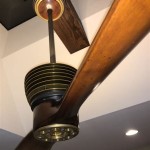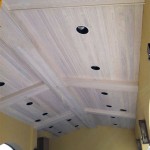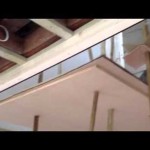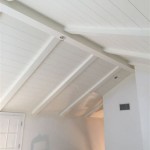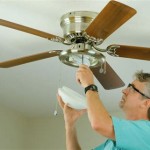Can You Put A Ceiling Fan On A Sloped Ceiling?
The question of whether a ceiling fan can be installed on a sloped or angled ceiling is a common one for homeowners and renters alike. The short answer is generally yes, but the feasibility and process depend on several factors, including the degree of the slope, the type of ceiling fan, and the mounting hardware available. Successfully installing a ceiling fan on a sloped ceiling requires careful planning, the right equipment, and adherence to safety guidelines.
Sloped ceilings, also sometimes called cathedral or vaulted ceilings, present a unique set of challenges compared to installing a fan on a flat, standard ceiling. The primary issue is ensuring the fan hangs level and operates safely and efficiently. A fan that isn’t properly aligned can wobble, create excessive noise, or even pose a safety hazard due to the risk of it detaching from the ceiling. Therefore, understanding the specific considerations for sloped ceiling installations is crucial before undertaking such a project.
This article will explore the key points to consider when installing a ceiling fan on a sloped ceiling, including assessing the slope, selecting the appropriate mounting hardware, and understanding the importance of airflow and aesthetics. We will also discuss potential challenges and provide guidance on ensuring a safe and functional installation.
Assessing the Ceiling Slope and Choosing the Right Mounting Kit
The first and perhaps most critical step in installing a ceiling fan on a sloped ceiling is accurately assessing the angle of the slope. This measurement will dictate the type of mounting hardware required. The slope is typically measured in degrees, and this information is essential for selecting a compatible downrod and mounting bracket. Some ceiling fan manufacturers specify the maximum permissible slope for their fans. Exceeding this slope can compromise the fan’s stability and performance.
Several methods can be used to determine the ceiling slope. A simple method involves using a level and a protractor. Hold the level against the ceiling and use the protractor to measure the angle between the level and the ceiling. Alternatively, specialized angle finders or digital levels can provide more precise measurements. In some cases, architectural plans or building specifications may include the ceiling slope, eliminating the need for manual measurement.
Once the slope is determined, the selection of the appropriate mounting kit becomes paramount. Standard ceiling fan mounting kits are designed for flat ceilings and are generally not suitable for sloped installations. Instead, a specialized sloped ceiling adapter or a downrod specifically designed for angled ceilings is required. These adapters typically feature a swivel mechanism that allows the fan to hang vertically, regardless of the ceiling’s angle. The downrod length is another crucial factor. A longer downrod may be necessary to ensure adequate clearance between the fan blades and the ceiling, especially on steeper slopes. Insufficient clearance can restrict airflow and reduce the fan’s efficiency.
The mounting bracket itself must also be compatible with the electrical box in the ceiling. The electrical box must be rated for ceiling fan use. Standard light fixture boxes are generally not strong enough to support the weight and vibrations of a ceiling fan and should never be used. If the existing electrical box is not fan-rated, it must be replaced with a suitable option before proceeding with the installation. This usually involves securing the box to a ceiling joist or using a brace specifically designed for ceiling fan installations.
Furthermore, consider the weight of the ceiling fan. Heavier fans may require stronger mounting hardware and additional support. Review the manufacturer's specifications for the maximum weight capacity of the mounting kit and ensure the chosen hardware can safely support the fan. In some cases, it may be necessary to reinforce the ceiling joists to provide additional support.
Downrod Length, Airflow, and Aesthetic Considerations
Selecting the appropriate downrod length is not only crucial for functionality but also for optimizing airflow and achieving the desired aesthetic. The correct downrod length ensures adequate clearance between the fan blades and the ceiling, allowing for optimal air circulation. As previously mentioned, insufficient clearance can hinder airflow and reduce the fan’s cooling or heating efficiency. A general rule of thumb is to have at least 7 feet of clearance between the floor and the fan blades. However, this may need to be adjusted based on the height of the ceiling and the presence of any obstructions, such as furniture or light fixtures.
The downrod length also influences the appearance of the fan. A longer downrod can make the fan appear more proportionate in rooms with high ceilings, while a shorter downrod may be more suitable for lower ceilings. Consider the overall design of the room and choose a downrod length that complements the existing décor. Downrods are available in various finishes, allowing you to match the fan to the other fixtures and hardware in the room.
Airflow is a primary consideration when determining the placement and type of ceiling fan for a sloped ceiling. The goal is to circulate air effectively throughout the room. In rooms with high ceilings, a ceiling fan can help to destratify the air, preventing warm air from rising to the ceiling and creating a more comfortable temperature at floor level. This is particularly beneficial during the winter months, as it can help to reduce heating costs. In the summer, the fan can create a cooling breeze, reducing the need for air conditioning.
When installing a ceiling fan on a sloped ceiling, consider the direction of the slope and the overall layout of the room. Positioning the fan in a way that maximizes airflow is crucial. Experiment with different fan speeds and directions to determine the most effective configuration for your specific space. Some ceiling fans offer reversible blades, allowing you to change the direction of airflow depending on the season.
Beyond functionality, aesthetics play a significant role in the overall appeal of a ceiling fan installation. Choose a fan that complements the style of the room and integrates seamlessly with the existing décor. Consider the finish, blade style, and overall design of the fan. There are countless options available, ranging from traditional to contemporary designs. Take the time to browse different styles and find a fan that reflects your personal taste and enhances the overall look of the room.
Safety Precautions and Installation Procedures
Safety should be the top priority when installing a ceiling fan on a sloped ceiling. Before beginning any electrical work, always turn off the power to the circuit at the breaker box. This will prevent the risk of electric shock. It is also advisable to use a voltage tester to confirm that the power is indeed off before touching any wires.
Carefully review the manufacturer’s instructions before starting the installation process. These instructions provide detailed guidance on the specific steps involved in installing the fan and should be followed meticulously. Pay close attention to any warnings or cautions provided by the manufacturer. If you are not comfortable working with electrical wiring or are unsure about any aspect of the installation, it is best to hire a qualified electrician. Improper installation can lead to electrical hazards, damage to the fan, or even structural damage to the ceiling.
When working on a ladder, always ensure it is placed on a stable surface and that you have a firm footing. Use a ladder that is tall enough to reach the ceiling comfortably without overextending. Have someone assist you with holding the ladder for added stability. Wear appropriate safety gear, such as safety glasses, to protect your eyes from dust and debris.
Double-check all wiring connections to ensure they are secure and properly insulated. Loose or poorly insulated connections can lead to electrical shorts or other hazards. Use wire connectors or electrical tape to insulate exposed wires. Ensure that the wiring is properly grounded to prevent electrical shocks.
Once the fan is installed, test it thoroughly to ensure it is working correctly. Check for any wobbling or excessive noise. If the fan is wobbling, try adjusting the angle of the blades or tightening the screws that secure the blades to the motor. If the problem persists, consult the manufacturer’s instructions or contact a qualified electrician.
Finally, remember to dispose of any packaging materials and old hardware properly. Recycle whenever possible. By following these safety precautions and installation procedures, you can ensure a safe and successful ceiling fan installation on a sloped ceiling.

How To Install A Ceiling Fan On Sloped Lemon Thistle

Install Ceiling Fan On Sloped Simple Modern Handmade Home

How To Choose A Ceiling Fan For Vaulted Ceilings Lightology

How To Install A Ceiling Fan On Sloped Lemon Thistle

Electrical Mount Ceiling Fan At The Peak Of A Sloped Home Improvement Stack Exchange

How To Find Ceiling Fans Slope Adapters And Downrods For Angled Ceilings Delmarfans Com

Ensuring Proper Ceiling Fan Installation With Vaulted Ceilings

How To Choose A Ceiling Fan For Vaulted Ceilings Lightology

Fitting A Ceiling Fan On To Sloping

Vaulted Sloped Ceiling Adapter For Modern Fan Company Fans Stardust
Related Posts


